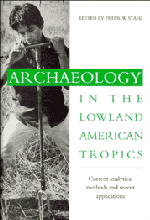Book contents
- Frontmatter
- Contents
- List of figures
- List of tables
- List of contributors
- Introduction
- 1 Archaeological survey and site discovery in the forested neotropics
- 2 The archaeology of community organization in the tropical lowlands: a case study from Puerto Rico
- 3 Archaeological methods for the study of ancient landscapes of the Llanos de Mojos in the Bolivian Amazon
- 4 Searching for environmental stress: climatic and anthropogenic influences on the landscape of Colombia
- 5 “Doing” paleoethnobotany in the tropical lowlands: adaptation and innovation in methodology
- 6 Plant microfossils and their application in the New World tropics
- 7 Differential preservation histories affecting the mammalian zooarchaeological record from the forested neotropical lowlands
- 8 Biological research with archaeologically recovered human remains from Ecuador: methodological issues
- 9 Interpreting dietary maize from bone stable isotopes in the American tropics: the state of the art
- 10 From potsherds to pots: a first step in constructing cultural context from tropical forest archaeology
- 11 Returning to Pueblo Viejo: history and archaeology of the Chachi (Ecuador)
- References
- Index
9 - Interpreting dietary maize from bone stable isotopes in the American tropics: the state of the art
Published online by Cambridge University Press: 23 November 2009
- Frontmatter
- Contents
- List of figures
- List of tables
- List of contributors
- Introduction
- 1 Archaeological survey and site discovery in the forested neotropics
- 2 The archaeology of community organization in the tropical lowlands: a case study from Puerto Rico
- 3 Archaeological methods for the study of ancient landscapes of the Llanos de Mojos in the Bolivian Amazon
- 4 Searching for environmental stress: climatic and anthropogenic influences on the landscape of Colombia
- 5 “Doing” paleoethnobotany in the tropical lowlands: adaptation and innovation in methodology
- 6 Plant microfossils and their application in the New World tropics
- 7 Differential preservation histories affecting the mammalian zooarchaeological record from the forested neotropical lowlands
- 8 Biological research with archaeologically recovered human remains from Ecuador: methodological issues
- 9 Interpreting dietary maize from bone stable isotopes in the American tropics: the state of the art
- 10 From potsherds to pots: a first step in constructing cultural context from tropical forest archaeology
- 11 Returning to Pueblo Viejo: history and archaeology of the Chachi (Ecuador)
- References
- Index
Summary
Archaeologists approach the reconstruction of prehistoric subsistence and ecology using macrobotanical, palynological, phytolith, and faunal evidence, along with functional studies of utilitarian tools and iconographic analyses of ceremonial artifacts. When a dependable subsistence staple such as storable maize or processed manioc flour is identified, this has further implications for population dynamics and social complexity. Inquiries about prehistoric settlement and subsistence patterns in the tropics often focus on the inclusion of maize as a dietary component, and when, if ever, it became a dietary staple (that is, a sustaining or principal food source). A series of interrelated questions about prehistoric maize are pertinent: When and where were its origins? Was it only a minor dietary component, or was it relied upon as a subsistence staple? Is its consumption linked to patterns of poor health or disease? Was it differentially consumed by certain social classes or age/sex categories? Are particular patterns of settlement associated with agricultural subsistence?
In complex environments like the American tropics, where species diversity is high and subsistence alternatives can be many, multiple lines of evidence are necessary to answer questions of subsistence, settlement, and agricultural origins. The stable isotopes of carbon and nitrogen in archaeological human remains can be one line of evidence used to provide additional information about these topics.
- Type
- Chapter
- Information
- Archaeology in the Lowland American TropicsCurrent Analytical Methods and Applications, pp. 198 - 223Publisher: Cambridge University PressPrint publication year: 1995
- 31
- Cited by



